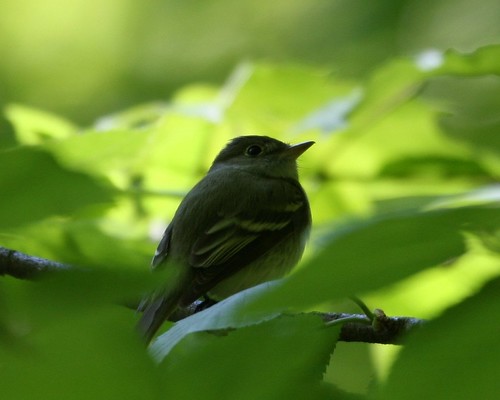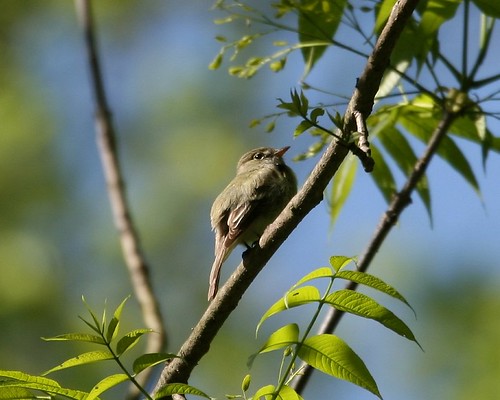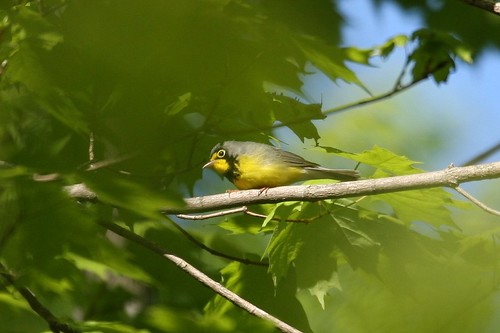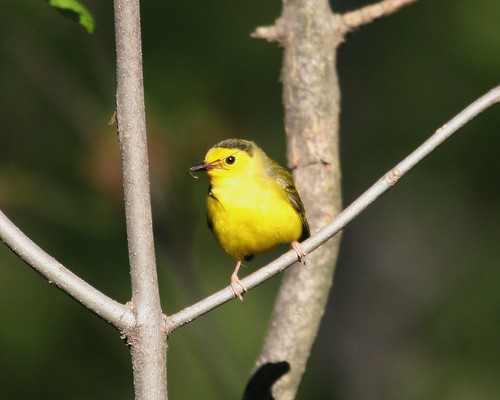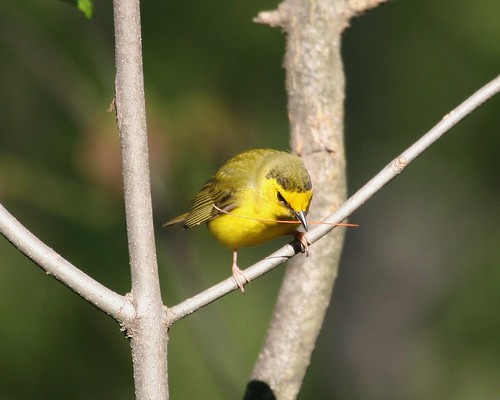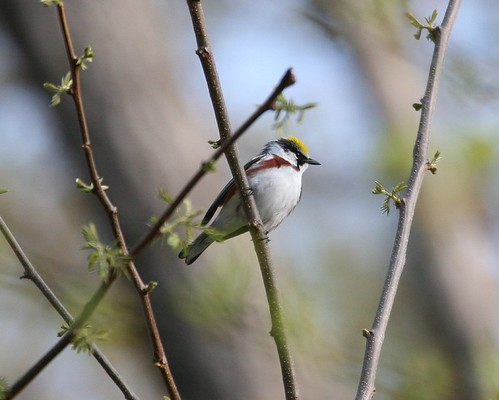Flycatchers make me nervous. Not nervous like I would be if I were a fly, but nervous like a student who hasn't studied enough and is walking into an exam. Which ones have the wing bars? Which ones *don't* have the wing bars? Is that one's song the "pizza" one, or the "free beer" one? Is this the right habitat for that one?
Okay...I have studied some, so I am not completely in the dark. For example, some songs are really easy to remember, like that of the Eastern Wood-Pewee. And if I am not sure I can put name to song in the field, I will take notes on the song and then identify the bird later by comparing it to songs on the Internet or on CDs that I have purchased.
On my most recent trip to South River Falls (seems like so long ago...but it was only a month back), I listened to and watched several flycatchers. On a couple of occasions I had long looks, and enough time to take some pictures. I remember hearing their song, recognizing them and then taking photographs of them. When I finally got around to scanning through my pictures, however, I was stymied for several moments as I tried to identify the very much non-singing flycatchers in my photographs. I did not realize how much I actually relied on their song to make the identification. I took a few moments, flipped through some field guides, compared to other photographs, and basically re-identified the birds. And I felt pretty silly.
So here are two photographs that I took of a flycatcher on that hike. The first is Acadian Flycatcher. The second is Eastern Wood-Pewee. The second photograph caused me the most trouble in my re-identification efforts, and I still have this tinge of doubt.
Showing posts with label South River Falls. Show all posts
Showing posts with label South River Falls. Show all posts
Canada Warbler
Each spring when I visit South River Falls, I always look forward to where the trail comes down to the stream that eventually tumbles over the falls as the South River. It is at this stream that I can reliably find Canada Warbler. Their song gives me my only real chance at finding the bird. They blend in so well with their surroundings that without that song I might look right at the bird and not even notice it.
When I finally do find the bird, I then hope for a photograph. A long lens, patience, and a bird that decides to sit still in the open are all required. I have the lens, and usually have the patience. The other two, I think, are just luck. Last year I managed to get a fuzzy shot of a Canada Warbler. This year was about the same.
When I finally do find the bird, I then hope for a photograph. A long lens, patience, and a bird that decides to sit still in the open are all required. I have the lens, and usually have the patience. The other two, I think, are just luck. Last year I managed to get a fuzzy shot of a Canada Warbler. This year was about the same.
Hooded Warbler
One of my recent hikes on South River Falls Trail (back in May) yielded the usual menagerie of spring migrants, including some that nest in the mountains of Virginia. One species in particular that nests in Shenandoah National Park is Hooded Warbler.
At the very start of my most recent visit, Tammy and I came across a Hooded Warbler that appeared to be gathering nesting material. I took several photos of the bird as it moved about the bushes very close to the ground. It was quite shady in those spots, so I set the ISO on my camera up to 400 in an attempt to compensate for the low light. When the bird suddenly perched in direct sunlight, I had time to snap several pictures that turned out to be above average. Unfortunately I did not have a chance to readjust the ISO back down to 100 before taking these, so they are a bit overexposed. But I will take what I can get :-)
At the very start of my most recent visit, Tammy and I came across a Hooded Warbler that appeared to be gathering nesting material. I took several photos of the bird as it moved about the bushes very close to the ground. It was quite shady in those spots, so I set the ISO on my camera up to 400 in an attempt to compensate for the low light. When the bird suddenly perched in direct sunlight, I had time to snap several pictures that turned out to be above average. Unfortunately I did not have a chance to readjust the ISO back down to 100 before taking these, so they are a bit overexposed. But I will take what I can get :-)
Ovenbird
Walk anywhere in Shenandoah National Park in the springtime and you will hear the singing of an Ovenbird. Their "teacher teacher teacher" song that gets louder as it goes (like someone is turning the volume up) is a sure sign of their presence. That song is easy to hear, but actually spotting the singing bird is a bit more challenging. You would think that their song would make it easier, but for whatever reason, I find them hard to locate visually even when they are singing away.
I had someone recently ask me how the Ovenbird got its name, and I was stumped. It is an odd name. Why go with something simple like Ovenbird when you could have something more eclectic like Scaly-throated Foliage-gleaner?
Okay...I apologize in advance for the detour, but here is where things get complicated. I had picked up my copy of The Birds of Costa Rica in order to find a really complicated bird name that I could contrast with Ovenbird. I flipped through, found Scaly-throated Foliage-gleaner, and was pleased with myself for finding such a mouthful. I wanted to include a link to something meaningful for that name, so I did some searching on Wikipedia. This is where I discovered that the Scaly-throated Foliage-gleaner just happens to be a member of a family of birds that is referenced by the term "ovenbird". Much to my dismay, the specific North American bird whose name is Ovenbird, is not a member of the family of birds (Furnarlidae) whose name is Ovenbird. Sigh.
So, where does the term "ovenbird" derive? Building a nest that is covered, with a side entrance, and has a passing resemblance to a dutch oven was the primary driver. The North American bird called Ovenbird apparently does this. Here are a couple photos of an Ovenbird (the North American kind) that I took on one of my recent South River Falls hikes.
I had someone recently ask me how the Ovenbird got its name, and I was stumped. It is an odd name. Why go with something simple like Ovenbird when you could have something more eclectic like Scaly-throated Foliage-gleaner?
Okay...I apologize in advance for the detour, but here is where things get complicated. I had picked up my copy of The Birds of Costa Rica in order to find a really complicated bird name that I could contrast with Ovenbird. I flipped through, found Scaly-throated Foliage-gleaner, and was pleased with myself for finding such a mouthful. I wanted to include a link to something meaningful for that name, so I did some searching on Wikipedia. This is where I discovered that the Scaly-throated Foliage-gleaner just happens to be a member of a family of birds that is referenced by the term "ovenbird". Much to my dismay, the specific North American bird whose name is Ovenbird, is not a member of the family of birds (Furnarlidae) whose name is Ovenbird. Sigh.
So, where does the term "ovenbird" derive? Building a nest that is covered, with a side entrance, and has a passing resemblance to a dutch oven was the primary driver. The North American bird called Ovenbird apparently does this. Here are a couple photos of an Ovenbird (the North American kind) that I took on one of my recent South River Falls hikes.
Chestnut-sided Warbler
I have to be careful when I tell people that I "go hiking", because they often assume that my purpose is to hike, as in "to get from point A to point B". If I ignored birds and all wildlife, and did not carry a camera, then I might hike that way. But it is very difficult for me to ignore birds or any wildlife, and I nearly always carry my camera, so my objective when I hike is definitely not focused on getting from point A to point B. In fact, if anyone ever suggests that it would be cool to accompany me on a hike, I immediately warn them about what I like to call "birdwatching pace". When I hike, I am slow. Really slow. Any bird song, or movement, or wildlife in general, will distract me and may result in incessant photographic attempts. It is not uncommon for me to average about 1 mile per hour when I hike. If the chosen trail is 6 miles long, then prepare for 6 hours of hiking that is punctuated by frequent stops to listen, look and photograph. I really enjoy the heck out of whatever trail I happen to hike :-)
Three of the last four weekends I have managed to get out to the mountains of Virginia and combine a hike with birdwatching and photography. Two of the three were on the South River Falls Trail within Shenandoah National Park. I really enjoy getting out to the mountains during spring migration because of the increased odds of seeing something more interesting. Last year I even caught a glimpse of an American Black Bear.
This, and the next few posts, will include photos from these trips. For this post, I elected to share one of the more common warblers that occur in the mountains of Virginia. As you descend in elevation in Virginia, the Chestnut-sided Warbler becomes less common to the point of being absent. But "on top" of the mountains, they are everywhere. Their "pleased pleased pleased to meetcha!" song rings out from all over the place. In the spring, when I arrive at the trail head for South River Falls Trail and get out of my car, the song of the Chestnut-sided Warbler is nearly always the one I hear first.
Three of the last four weekends I have managed to get out to the mountains of Virginia and combine a hike with birdwatching and photography. Two of the three were on the South River Falls Trail within Shenandoah National Park. I really enjoy getting out to the mountains during spring migration because of the increased odds of seeing something more interesting. Last year I even caught a glimpse of an American Black Bear.
This, and the next few posts, will include photos from these trips. For this post, I elected to share one of the more common warblers that occur in the mountains of Virginia. As you descend in elevation in Virginia, the Chestnut-sided Warbler becomes less common to the point of being absent. But "on top" of the mountains, they are everywhere. Their "pleased pleased pleased to meetcha!" song rings out from all over the place. In the spring, when I arrive at the trail head for South River Falls Trail and get out of my car, the song of the Chestnut-sided Warbler is nearly always the one I hear first.
Scarlet Tanager
One of my favorite birds to see during Spring migration is Scarlet Tanager. That vivid red and black combination on the males is just beautiful, and it jumps out at you when you see it against the background of green foliage, or a blue sky. These pictures are from my recent hike on South River Falls Trail. While I was lucky enough to see two male Scarlet Tanagers in the same tree at the same time, I still had to choose which one to photograph since they were not posing side by side.




American Redstart
When I hiked the South River Falls Trail, one of the more common birds that I saw was American Redstart. When I say "common", I mean it. They were everywhere. By the end of the hike I was mumbling to myself "yet another Redstart" after taking the time to follow some movement in the trees with my binoculars so that I could identify its source. And like most Warblers, these birds are not what you could call passive. They are always on the move looking for the next tasty bug to catch and eat. In fact, one of the tricks used by American Redstart is to fan its orange and black tail in an attempt to flush insects out for the snagging.
Somehow I managed to get a reasonable photo of a male American Redstart. I have made many attempts at getting a photo of an American Redstart, but they usually move much faster than I can point and focus my camera. Either I got lucky, or this one took pity on me.

Somehow I managed to get a reasonable photo of a male American Redstart. I have made many attempts at getting a photo of an American Redstart, but they usually move much faster than I can point and focus my camera. Either I got lucky, or this one took pity on me.

Black-and-white Warbler
The color pattern and tree climbing behavior of a Black-and-white Warbler make me think of a White-breasted Nuthatch in a Zebra suit. That is, however, where any similarity (if you can even call it that) ends.
I took these photos of a Black-and-White Warbler while hiking the South River Falls Trail (pdf) in Shenandoah. The first shows an attempt at grabbing a meal. The second is a very brief moment of rest for the bird. Usually they are very active and nearly always moving.


I took these photos of a Black-and-White Warbler while hiking the South River Falls Trail (pdf) in Shenandoah. The first shows an attempt at grabbing a meal. The second is a very brief moment of rest for the bird. Usually they are very active and nearly always moving.


Red-eyed Vireo
One of the things I notice most when Spring arrives in Virginia are the Red-eyed Vireos. They winter in South America, and arrive back in Virginia in early Spring. Most of the time you do not see them because they are in the canopy of trees picking bugs off of leaves. In the Spring and Summer, however, they sing pretty incessantly during the day, so it is very easy to detect their presence, even if you do not actually see them.
Here are a couple of photos I managed to get of Red-eyed Vireos while hiking South River Falls Trail.


Here are a couple of photos I managed to get of Red-eyed Vireos while hiking South River Falls Trail.


Bear Sighting
It is fairly well known that Virginia has a nice population of American Black Bears, and that population tends to favor the habitat found in the western part of the state, including Shenandoah National Park. On the other hand, I have visited the western part of the state many times, including Shenandoah and the Appalachian Trail, and have only seen a bear one time. That one time was a fleeting glance of a very distant bear while hiking up White Oak Canyon Trail.
That is until my recent trip to South River Falls Trail.
I was taking my time hiking back up from the falls. My pace was what I call "bird watching speed" instead of "hiking speed". The total distance of the hike was somewhere around 3.5 miles, and I took 5 and a half hours to hike it. As I hiked, I would periodically stop when I heard or saw something that warranted some investigation. Other times I would just stop to listen and wait on the off chance that something would be moving through the trees and pass me. I was expecting that "something" to be avian. When I noticed movement down slope from me that was dark, furry and not small, I realized my interest in just birds was a tad too focused.
I was so excited about seeing a bear that my pictures suffered. The only photos where you can tell there is a bear are when the bear's head is behind a tree. The bear was probably only about 20 yards away, down slope from the trail. I had no indication that the bear ever took notice of me (which in hind sight is a good thing). My theory is that it had a den down there because it moved behind a pile of brush and fallen trees and it never came back into view over the next 15 minutes (when I decided to move along).
So, here is my lame bear picture. Hopefully you can tell there is a bear in the photo, even if it is headless. At the rate I am seeing bears in Shenandoah, I should see another one in about two years. I will be better prepared to get a good photo when that happens!

That is until my recent trip to South River Falls Trail.
I was taking my time hiking back up from the falls. My pace was what I call "bird watching speed" instead of "hiking speed". The total distance of the hike was somewhere around 3.5 miles, and I took 5 and a half hours to hike it. As I hiked, I would periodically stop when I heard or saw something that warranted some investigation. Other times I would just stop to listen and wait on the off chance that something would be moving through the trees and pass me. I was expecting that "something" to be avian. When I noticed movement down slope from me that was dark, furry and not small, I realized my interest in just birds was a tad too focused.
I was so excited about seeing a bear that my pictures suffered. The only photos where you can tell there is a bear are when the bear's head is behind a tree. The bear was probably only about 20 yards away, down slope from the trail. I had no indication that the bear ever took notice of me (which in hind sight is a good thing). My theory is that it had a den down there because it moved behind a pile of brush and fallen trees and it never came back into view over the next 15 minutes (when I decided to move along).
So, here is my lame bear picture. Hopefully you can tell there is a bear in the photo, even if it is headless. At the rate I am seeing bears in Shenandoah, I should see another one in about two years. I will be better prepared to get a good photo when that happens!

White-throated Sparrow
While hiking the South River Falls Trail, some movement in a brush pile caught my attention. I was taking pictures of a bird before I knew what it was. In this case, it was a White-throated Sparrow, which is common and kind of a let down when placed on the scale of potential birds to be seen. Those yellow lores are cool, though.


Canada Warbler
As you walk down the South River Falls Trail, the trail will eventually come down to the stream that leads to the waterfall. It is at this point, and for the next mile or so, that you can reliably find Canada Warblers staking out territory in the spring. They flit about in the newly leafed-out trees, over top the stream itself, singing away. If you know their song, you will have a much better chance of finding them in the foliage.




American Robin
The American Robin can sometimes be placed into the category of birds called "trash birds" - birds that are so common and regular that they clutter the search for the rare or uncommon species. Whether or not an American Robin is considered a "trash bird" obviously depends heavily on where you are located. If you saw one in, for example, South America, it would definitely not be a "trash bird". At South River Falls Picnic Area, however, it is probably often considered a "trash bird".
After I arrived at the picnic area last Sunday I scanned the area for any bird activity. It was cold for May, so not many birds were active. There were a few Robins flitting about on the grass, so I got my camera fingers warmed up for the day by taking some pictures.

After I arrived at the picnic area last Sunday I scanned the area for any bird activity. It was cold for May, so not many birds were active. There were a few Robins flitting about on the grass, so I got my camera fingers warmed up for the day by taking some pictures.

Eastern Towhee
The start of the South River Falls trail is at the back edge of the South River Falls picnic area, just a few miles north of where U.S. Route 33 crosses the Skyline Drive at Swift Run Gap. There is a small grassy area just to the left of the trail head, which is where I found this female Eastern Towhee rummaging around in the leaves for food. The female looks different than the male. Her head, back and upper breast are a chocolate brown color, but the male is black in those areas. It is also worth noting that the eye color of Eastern Towhees in Florida and southern Georgia are straw colored, and variable as far north as North Carolina. Across most of the range, however, the eye color is red, just like in this picture.


Eastern Phoebe
Okay, switching gears now. Here is the first picture from my trip to South River Falls this past Sunday. Rich's post yesterday with that beautiful Red-headed Woodpecker has me refocused on quality instead of quantity. While I am not sure that I will regularly (or ever) achieve the quality that Rich's photography exhibits, I will still try to avoid posting below average pictures of things.
On that note, here is a photo of an Eastern Phoebe, a fairly common variety of flycatcher.

On that note, here is a photo of an Eastern Phoebe, a fairly common variety of flycatcher.

South River Falls
When I got back from Louisiana, I speculated that I might visit Shenandoah National Park this weekend. One of my favorite places to bird watch during spring migration is South River Falls Trail. It is easy to get to, always a good hike, and, during spring migration, there are lots of birds to see. Today was no exception.
I arrived at the trail head around 8am this morning. It was a tad cold for early May, and I had to start with gloves and a wool hat to cover my ears. The gloves came off within 30 minutes because it was too weird taking pictures with them on. The hat came off in another 90 minutes after things warmed up a bit more. At first, I was afraid it was going to be a waste of bird watching time because there were very few birds at the trail head. But as I walked down the trail towards the fall, three things happened: it got warmer, the trees got leafier and the birds started making their presence known.
Today turned out to be an 11 warbler day, including a lifer for me: Cerulean Warbler. I realized today that I had been confusing the Cerulean's song with the song of Northern Parula. What I thought of as the "short cut" Parula song was really the Cerulean. It was great when I connected the song with the bird, because I realized what I had been missing on my previous trips to this trail.
Other highlights included seeing 2 Scarlet Tanagers, 2 Blackburnian Warblers, 1 American Redstart and 1 Red-eyed Vireo all stopping in the same two trees in front of me within about 5 minutes of each other. I just stood there and tried to take pictures as they flew in, hopped about and then flew on to their next stop.
And, to top it off, I also saw a Black Bear. I was standing on the trail watching the trees for birds (a pessimist would say that I was resting on my way back up from the falls :-) when I looked down the slope and saw something move. It was black, furry and not small. I actually got a couple of pictures of it, but its head is behind a tree so all you see is a big black furry body. It either lay down to sleep, or has much better stealth than I thought, because I never saw it again despite looking for another 10 minutes.
So, where are the pictures? They are coming. I took a ton of pictures so there are bound to be a few good ones in there. I think I have a couple more to share from my last Louisiana field trip, and then I will start working my way through the photos from today. If you are a glutton for punishment, you can look at all of the thumbnails from today here. As I write this, all of the thumbnails are uploaded, but there are still 255 full-sized images to upload (they should be done by uploading by tomorrow). None of the junk or repetition has been hidden, and nothing has been cropped.
[Edit: removed link to thumbnails at Phanfare]
I arrived at the trail head around 8am this morning. It was a tad cold for early May, and I had to start with gloves and a wool hat to cover my ears. The gloves came off within 30 minutes because it was too weird taking pictures with them on. The hat came off in another 90 minutes after things warmed up a bit more. At first, I was afraid it was going to be a waste of bird watching time because there were very few birds at the trail head. But as I walked down the trail towards the fall, three things happened: it got warmer, the trees got leafier and the birds started making their presence known.
Today turned out to be an 11 warbler day, including a lifer for me: Cerulean Warbler. I realized today that I had been confusing the Cerulean's song with the song of Northern Parula. What I thought of as the "short cut" Parula song was really the Cerulean. It was great when I connected the song with the bird, because I realized what I had been missing on my previous trips to this trail.
Other highlights included seeing 2 Scarlet Tanagers, 2 Blackburnian Warblers, 1 American Redstart and 1 Red-eyed Vireo all stopping in the same two trees in front of me within about 5 minutes of each other. I just stood there and tried to take pictures as they flew in, hopped about and then flew on to their next stop.
And, to top it off, I also saw a Black Bear. I was standing on the trail watching the trees for birds (a pessimist would say that I was resting on my way back up from the falls :-) when I looked down the slope and saw something move. It was black, furry and not small. I actually got a couple of pictures of it, but its head is behind a tree so all you see is a big black furry body. It either lay down to sleep, or has much better stealth than I thought, because I never saw it again despite looking for another 10 minutes.
So, where are the pictures? They are coming. I took a ton of pictures so there are bound to be a few good ones in there. I think I have a couple more to share from my last Louisiana field trip, and then I will start working my way through the photos from today. If you are a glutton for punishment, you can look at all of the thumbnails from today here. As I write this, all of the thumbnails are uploaded, but there are still 255 full-sized images to upload (they should be done by uploading by tomorrow). None of the junk or repetition has been hidden, and nothing has been cropped.
[Edit: removed link to thumbnails at Phanfare]
Subscribe to:
Posts (Atom)
